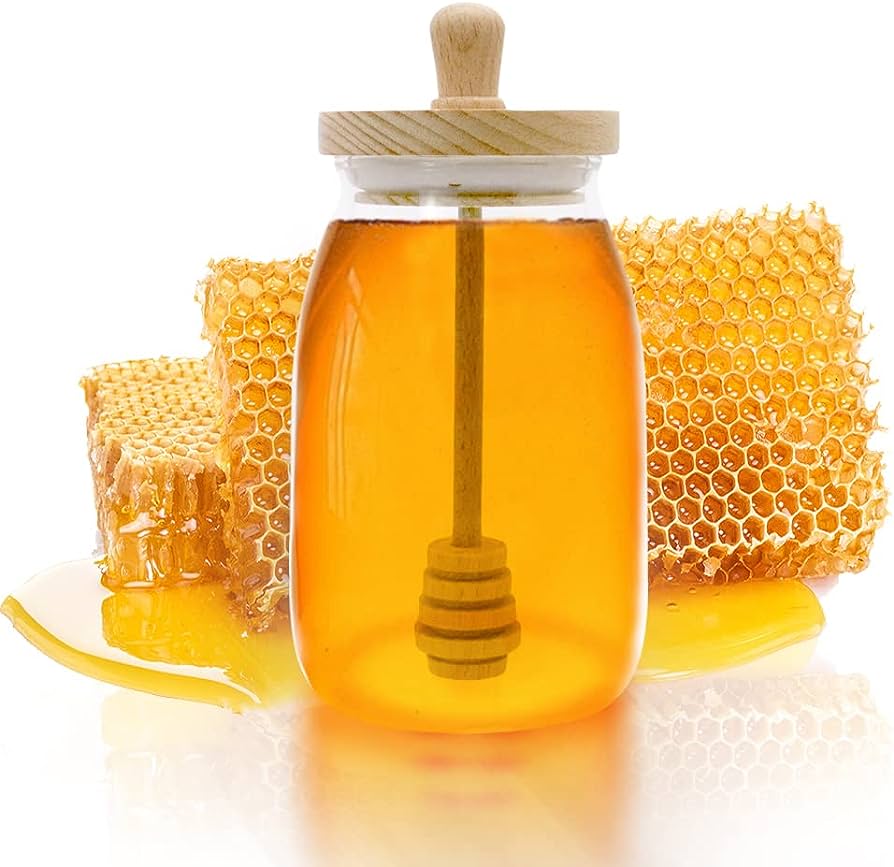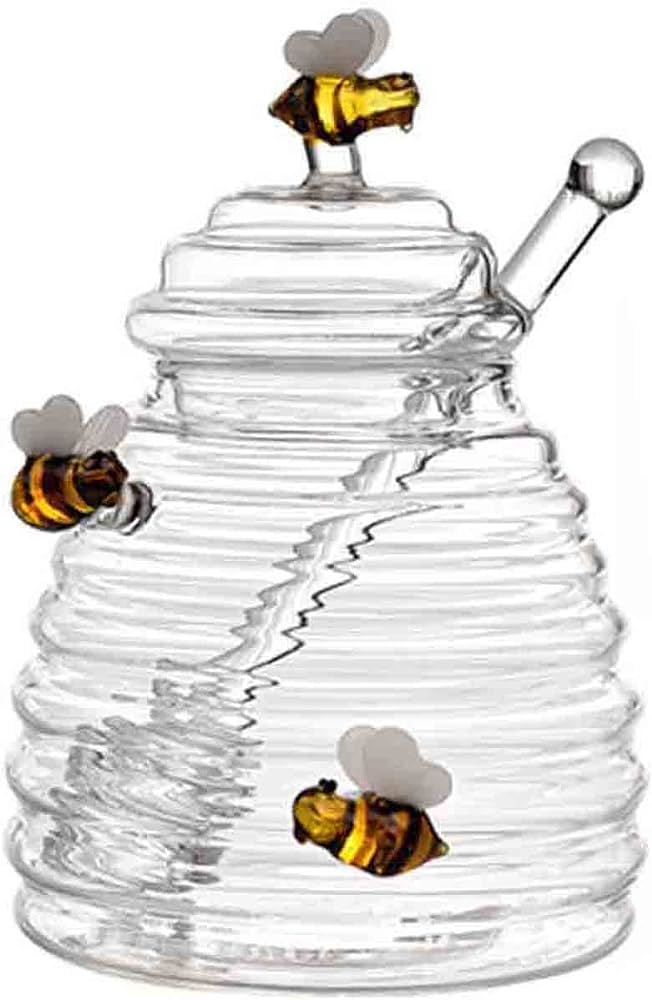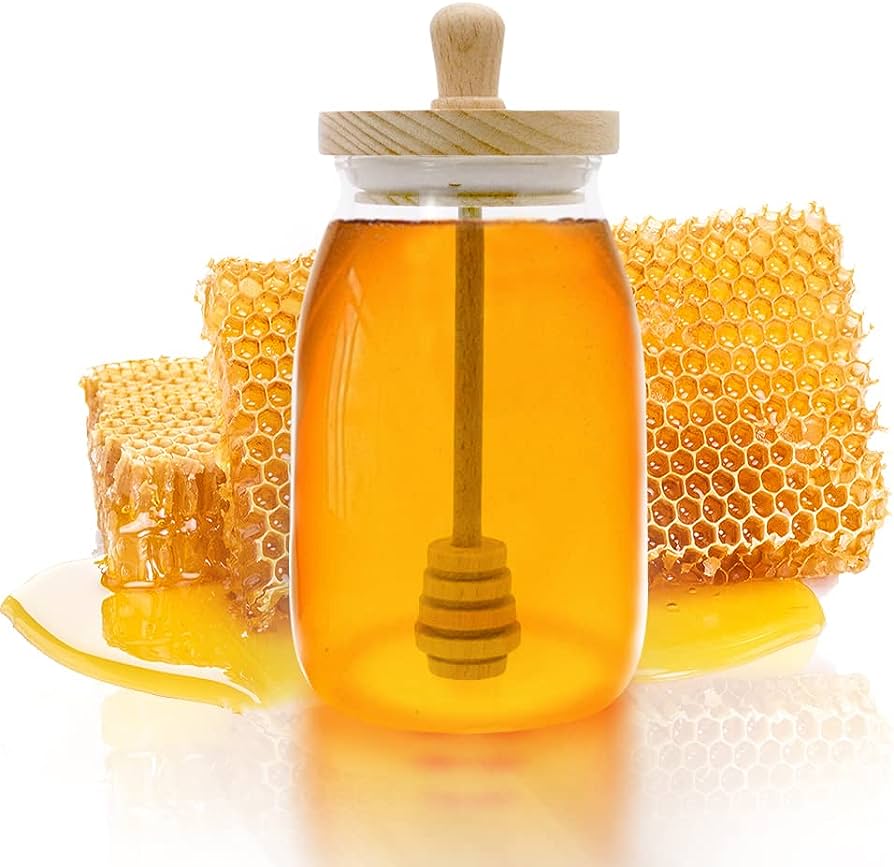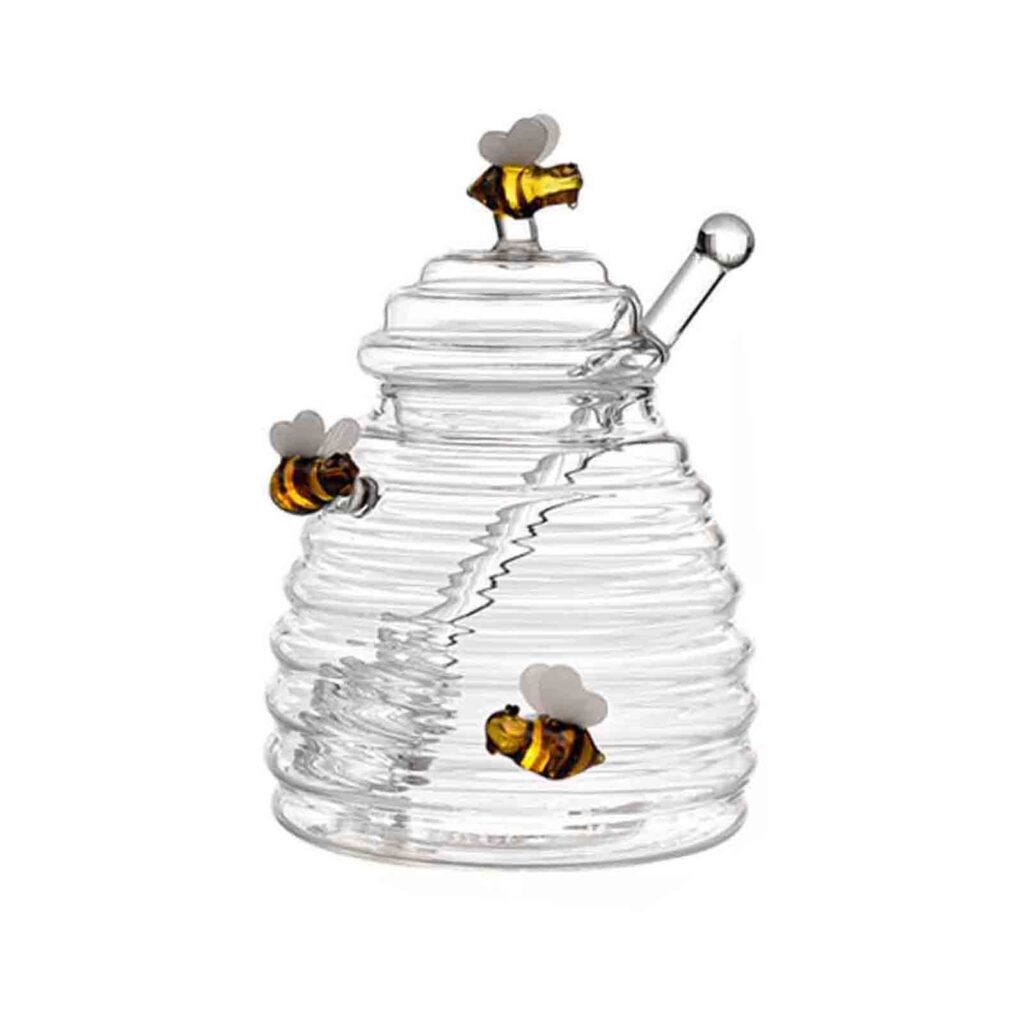
Imagine a world where you could have the most beautiful and practical containers for your precious honey collection. Well, your dream has come true! In this article, we will explore the ultimate honey pots that every bee lover needs. From elegant glass jars to rustic ceramic containers, we have curated a list of the top choices to store and display your golden liquid. Prepare to be inspired and find the perfect honey pot to enhance your beekeeping experience.

1. Glass Jars
1.1 Benefits of Using Glass Jars
Glass jars are the perfect choice for storing honey because they offer a multitude of benefits. First and foremost, glass is non-porous and non-reactive, which means it won’t absorb any flavors or odors from the honey. This ensures that the honey retains its natural taste and aroma. Additionally, glass is transparent, allowing you to easily see the beautiful golden color and texture of the honey. This can enhance your overall honey experience and make it even more enticing. Glass jars also provide an airtight seal, preventing any moisture or contaminants from entering the jar and compromising the quality of your honey. Lastly, glass is an eco-friendly option as it is 100% recyclable and can be reused for other purposes after cleaning.
1.2 Popular Brands of Glass Jars
When it comes to glass jars for honey storage, there are several popular brands known for their quality and reliability. One such brand is Ball, which offers a wide range of glass jars in various sizes suitable for honey storage. Another renowned brand is Weck, known for its iconic glass jars with rubber gaskets and stainless steel clamps that provide an airtight seal. Kilner is another brand that specializes in glass jars with clip-top lids, perfect for preserving the freshness of your honey. Lastly, Le Parfait is a well-known brand for its French-style glass jars, featuring a unique rubber gasket and metal clamp system that ensures a tight seal.
1.3 Tips for Choosing the Right Glass Jar
When choosing a glass jar for honey storage, there are a few important factors to consider. Firstly, look for a jar with a wide mouth opening, as this will make it easier to fill and scoop honey from the jar. Additionally, consider the size of the jar based on your honey consumption. If you’re a casual honey lover, a smaller jar may be sufficient, but if you’re a beekeeper or enjoy honey regularly, a larger jar would be more suitable. It’s also essential to ensure that the glass jar you choose comes with an airtight lid or closure mechanism to maintain the freshness of your honey. Finally, opt for a high-quality glass jar that is sturdy and thick to prevent breakage and ensure the longevity of your honey storage solution.
2. Ceramic Pots
2.1 Advantages of Ceramic Pots
Ceramic pots are a timeless and elegant choice for storing honey. There are several advantages to using ceramic pots for honey storage. Firstly, ceramic is an excellent insulator, which means it helps maintain a consistent temperature for your honey. This is especially crucial if you live in a region with fluctuating temperatures, as it prevents your honey from crystallizing or becoming too runny. Additionally, ceramic pots are non-reactive, ensuring that the honey’s taste and quality remain intact. Ceramic pots also add a touch of aesthetic appeal to your kitchen or honey display, as they come in various designs, colors, and patterns. Lastly, ceramic pots can be easily sealed, providing airtight storage that preserves the freshness and flavor of your honey.
2.2 Best Ceramic Pots for Honey Storage
When it comes to choosing the best ceramic pots for honey storage, several options stand out. One popular brand is Beehive Handmade, known for its handcrafted ceramic honey pots with adorable bee-themed designs. These pots not only provide excellent storage but also serve as decorative pieces that add character to your kitchen or dining table. Another noteworthy brand is Polish Pottery, which offers a wide selection of ceramic pots in vibrant colors and intricate patterns. These pots are made using unique pottery techniques and are highly durable. Additionally, Emma Bridgewater is renowned for its beautifully hand-painted ceramic pots, featuring charming designs that perfectly complement the sweetness of honey.
2.3 Cleaning and Care Guidelines for Ceramic Pots
To ensure the longevity and cleanliness of your ceramic honey pot, it’s essential to follow proper cleaning and care guidelines. Firstly, always hand wash your ceramic pot using warm water, mild dish soap, and a soft sponge or cloth. Avoid using abrasive cleaning tools or harsh chemicals that may scratch or damage the surface of the pot. Additionally, make sure to remove any remaining honey residue by rinsing the pot thoroughly and allowing it to air dry. Never expose a ceramic pot to extreme temperature changes, as this can cause it to crack or break. Lastly, store your ceramic pot in a cool and dry place away from direct sunlight or heat sources to maintain its overall quality and appearance.
3. Stainless Steel Containers
3.1 Why Stainless Steel is a Good Choice
Stainless steel containers are an excellent choice for beekeepers and honey enthusiasts alike. There are several reasons why stainless steel is favored for honey storage. First and foremost, stainless steel is incredibly durable and resistant to corrosion, ensuring that your honey remains safe and uncontaminated. This makes it ideal for long-term storage and transportation purposes. Stainless steel is also non-reactive and non-porous, meaning it won’t alter the taste, color, or aroma of your honey. Moreover, stainless steel containers offer excellent heat resistance, which can be beneficial if you need to warm your honey or place it in a warm environment. Lastly, stainless steel is easy to clean and maintain, making it a practical option for honey storage.
3.2 Top Stainless Steel Containers for Beekeepers
When it comes to top stainless steel containers for beekeepers, a few brands stand out. Mann Lake is a well-known brand that offers stainless steel containers specifically designed for beekeepers. They provide options like stainless steel honey tanks, buckets, and barrels in various sizes, allowing you to store large quantities of honey safely. Another reputable brand is VIVO, which specializes in stainless steel honey separators and filters. These containers enable beekeepers to extract honey from the comb and separate impurities, ensuring a pure and high-quality end product. Additionally, Brushy Mountain Bee Farm offers stainless steel honey storage tanks equipped with convenient features like honey gates and handles for easy dispensing and transport.
3.3 Maintaining Stainless Steel Containers
To maintain the quality and longevity of your stainless steel honey containers, proper maintenance is essential. Firstly, after each use, rinse the containers thoroughly with warm water to remove any honey residues. Use a soft sponge or non-abrasive brush to clean the inside and outside of the container. If necessary, you can use a mild detergent or vinegar solution to remove any stubborn stains or odors. Avoid using abrasive cleaners or scrubbers that can leave scratches on the stainless steel surface. After cleaning, make sure to dry the containers completely to prevent moisture build-up and potential rusting. Lastly, store your stainless steel containers in a cool and dry place to prevent any damage or discoloration.
4. Plastic Honey Bears
4.1 Pros and Cons of Plastic Honey Bears
Plastic honey bears have become a popular choice for honey storage due to their convenience and affordability. However, it’s essential to consider both the pros and cons before opting for plastic honey bear containers. One significant advantage of plastic honey bears is their lightweight nature, making them easy to handle and transport. Plastic is also shatterproof, reducing the risk of breakage in case of accidental drops. Moreover, plastic honey bears are typically transparent, allowing you to easily see how much honey is left in the container. On the downside, plastic is not as durable as other materials, and over time, it may absorb odors and flavors, affecting the quality of your honey. Additionally, plastic containers are not as airtight as glass or stainless steel options, which may result in honey spoilage or fermentation if not properly sealed.
4.2 Recommended Plastic Honey Bear Brands
When it comes to choosing reliable plastic honey bear brands, several options are worth considering. One popular brand is Honibe, which offers BPA-free plastic honey bears known for their quality and functionality. These honey bears come with easy-to-use squeeze tops, making it effortless to dispense honey. Another reputable brand is Creative Hobbies, which provides food-grade plastic honey bears with leak-resistant lids. These bears are designed with convenience in mind and are ideal for those who require smaller portions of honey regularly. Additionally, Mann Lake is a trusted brand that offers plastic honey bears specifically designed for beekeepers. These bears come in various sizes and are compatible with honey gates, making honey extraction and storage a breeze.
4.3 Proper Handling and Storage of Plastic Honey Bears
To ensure the proper handling and storage of plastic honey bears, a few guidelines should be followed. Firstly, make sure to tightly twist the cap or lid on the honey bear to create a secure seal. This will prevent any leakage or contamination of the honey. It’s also crucial to store plastic honey bears in a cool and dry place, away from direct sunlight or heat sources. Exposure to heat can cause the plastic to degrade, potentially leading to leaks or warping of the container. Additionally, avoid using sharp utensils or objects to scrape the honey bear, as this can damage the plastic surface. Lastly, it’s best to consume honey stored in plastic honey bears within a reasonable timeframe to ensure the quality and freshness of the honey.

5. Tin Containers
5.1 Advantages of Using Tin Containers
Tin containers have a charming and vintage appeal that can add a unique touch to your honey storage. There are several advantages to using tin containers for honey. Firstly, tin is a lightweight material, making it easy to handle and transport your honey. Tin containers are also known for their durability, as they can withstand everyday use and resist dents or cracks. Moreover, tin is non-reactive, ensuring that the taste and quality of your honey remain unaffected. Additionally, tin containers provide an airtight seal, preventing any air or moisture from entering and compromising the freshness of your honey. Lastly, tin is a recyclable material, making it an eco-friendly choice for those looking to reduce their environmental impact.
5.2 Noteworthy Tin Container Options
When it comes to noteworthy tin container options for honey storage, several choices are worth exploring. One popular brand is Keller Charles, which offers decorative tin containers with honey-themed designs. These tins come in various sizes and feature vibrant colors and intricate patterns that add a touch of elegance to your honey display. Another brand to consider is Lily’s Home, known for its vintage-inspired tin containers with nostalgic designs. These tins are perfect for those looking to create a retro vibe and showcase their love for honey in a unique way. Additionally, Park Designs offers tin containers with rustic and farmhouse-inspired designs, perfect for a cozy and charming honey storage solution.
5.3 Storage Tips for Tin Containers
To ensure the longevity and freshness of your honey stored in tin containers, it’s important to follow proper storage tips. Firstly, make sure to clean the tin container thoroughly before filling it with honey. Any dirt or residue on the surface of the tin can contaminate the honey and affect its quality. Additionally, always seal the tin container tightly to create an airtight seal. This will prevent any air or moisture from entering and preserving the freshness of your honey. It’s also advisable to store tin containers in a cool and dry place away from direct sunlight or heat sources. Extreme temperatures can cause the tin to expand or contract, potentially compromising the seal or integrity of the container.
6. Wooden Honey Pots
6.1 The Charm of Wooden Honey Pots
Wooden honey pots exude a rustic and natural charm that can enhance your honey storage experience. There are several reasons why wooden honey pots hold a special appeal. Firstly, wood is a sustainable and eco-friendly material, making it an ideal choice for those conscious of their environmental impact. Wooden honey pots are often handcrafted, adding a unique and artistic touch to your honey storage. Additionally, wood has natural insulating properties, which can help regulate the temperature inside the pot and prevent crystallization or flavor alteration of your honey. Lastly, wooden pots create a warm and cozy atmosphere, making them perfect for gifting or displaying your honey collection.
6.2 Handcrafted Wooden Pots for Bee Lovers
When it comes to handcrafted wooden honey pots, several options cater to bee lovers seeking artisanal and unique designs. One notable brand is The Honey Pot Company, which offers handcrafted wooden honey pots made from sustainably sourced wood. These pots feature intricate carvings and engravings that celebrate the beauty of bees and honey. Another brand to consider is Wild and Free Supply, known for its hand-turned wooden honey pots crafted from reclaimed wood. These pots have a rustic and natural appeal that will undoubtedly impress any honey enthusiast. Additionally, Beehive Woodcraft offers custom-made wooden honey pots, allowing you to create a personalized piece that reflects your love for honey.
6.3 Maintenance and Handling of Wooden Honey Pots
To ensure the proper maintenance and handling of your wooden honey pots, a few guidelines should be followed. Firstly, it’s important to treat the wooden surface of the pot with a food-safe finish or sealant. This will help protect the wood from moisture and prevent any warping or cracking. Additionally, avoid exposing the wooden pot to extreme temperatures or changes in humidity, as this can damage the wood. It’s recommended to hand wash the wooden pot using warm water and mild soap, ensuring a quick rinse and thorough drying afterward. Avoid soaking the pot for prolonged periods or using harsh cleaning agents that can strip away the protective finish. Lastly, periodically check for any signs of wear or damage, and promptly address any issues to ensure the longevity of your wooden honey pot.

7. Vintage Honey Jars
7.1 The Appeal of Vintage Honey Jars
Vintage honey jars have a fascinating allure that captures the nostalgia and history associated with honey production. There are several reasons why vintage honey jars have gained such appeal. Firstly, they often feature unique and intricate designs, reflecting the craftsmanship and attention to detail of a bygone era. Vintage honey jars can add a touch of charm and elegance to your honey collection, making them perfect display pieces. Additionally, these jars often come with a sense of history and story, sparking curiosity and interest among honey enthusiasts. Moreover, vintage honey jars can be considered collectors’ items, as they are often sought after by those who appreciate the beauty and historical significance of honey production.
7.2 Sought-after Vintage Honey Jar Designs
When it comes to seeking sought-after vintage honey jar designs, a few options are particularly renowned among collectors and enthusiasts. The Hazel Atlas Beehive jar is one of the most iconic vintage honey jar designs, featuring a distinctive beehive shape and intricate embossing. These jars are highly sought after and are considered true treasures among honey aficionados. The Ball Mason jar with the honeycomb pattern is another beloved vintage design, embodying the essence of honey production. These jars often come in various sizes and are perfect for both storage and display purposes. Lastly, the Pint Mason jar with the bee skep design is a classic vintage honey jar option that showcases the connection between honey and bees in an artistic and nostalgic way.
7.3 Preserving and Displaying Vintage Honey Jars
To ensure the preservation and exquisite display of your vintage honey jars, a few considerations should be taken into account. Firstly, it’s crucial to handle vintage honey jars with care, as they are often delicate and may be susceptible to damage. Avoid dropping or mishandling the jars to prevent any chips or cracks. Additionally, it’s best to store vintage honey jars in a secure and stable location, away from excessive heat, sunlight, or humidity that can potentially affect their integrity. If possible, it’s recommended to display your vintage honey jars in a cabinet or shelf with proper support to minimize the risk of accidental falls. Lastly, periodically clean the jars gently using warm water and mild soap, taking care not to scrub too hard or use any abrasive materials that may damage the jar’s surface or designs.
8. Plastic Squeeze Bottles
8.1 Convenience of Plastic Squeeze Bottles
Plastic squeeze bottles offer unparalleled convenience when it comes to dispensing and serving honey. There are several advantages to using plastic squeeze bottles for honey storage. Firstly, plastic squeeze bottles are lightweight and easy to handle, making them ideal for both home use and on-the-go situations. These bottles often come with squeezable sides and a tight-fitting cap or lid, allowing for precise control when pouring or drizzling honey. Plastic squeeze bottles are also transparent, enabling you to see the honey level and monitor how much honey is left. Moreover, plastic is a durable and shatterproof material, eliminating the risk of breakage in case of accidental drops. Lastly, plastic squeeze bottles are affordable and readily available, making them a practical choice for honey enthusiasts.
8.2 Reliable Plastic Squeeze Bottle Brands
When it comes to reliable plastic squeeze bottle brands, several options stand out in terms of quality and functionality. One well-known brand is OXO, which offers food-grade plastic squeeze bottles designed for precision pouring and easy cleanup. These bottles come with a narrow opening and a leakproof cap, ensuring no mess or drips. Another reputable brand is Wilton, famous for its squeeze bottles with a unique stand-up design and flexible silicone tip for controlled dispensing. These bottles are perfect for intricate honey drizzling or decorating purposes. Additionally, Norpro offers plastic squeeze bottles with adjustable caps that allow for customized dispensing, from a fine stream to a wide pour. These versatile bottles are perfect for various honey applications.
8.3 Proper Cleaning and Sanitization of Plastic Squeeze Bottles
To maintain the cleanliness and hygiene of your plastic squeeze bottles, it’s essential to follow proper cleaning and sanitization practices. Firstly, disassemble the bottle by removing the cap or lid and any accompanying nozzle or tip. Rinse all components thoroughly with warm water to remove any honey residues. Use a bottle brush or a small cleaning brush to clean the inside of the bottle, ensuring that all nooks and crevices are well scrubbed. It’s best to use a mild detergent or dish soap and rinse the bottle thoroughly to remove any soap residue. After cleaning, sanitize the bottle and its components by immersing them in a sanitizing solution, such as a mixture of water and bleach or a food-grade sanitizer. Rinse the bottle once again with clean water and allow it to air dry completely before reassembling and storing it.

9. Recycled Containers
9.1 Eco-friendly Options for Honey Storage
Using recycled containers for honey storage is an excellent choice for those looking to reduce waste and embrace eco-friendly practices. There are several options when it comes to using recycled containers for honey. Firstly, glass jars from other food products like sauces or jams can be thoroughly cleaned and repurposed for honey storage. These jars often come with secure closures, making them suitable for maintaining the freshness of your honey. Secondly, plastic containers from items like yogurt or honey itself can be washed and reused for honey storage. It’s important to ensure that these containers are made of food-grade plastic and are thoroughly cleaned before repurposing. Lastly, consider exploring local thrift stores or online platforms for vintage or second-hand containers that can be given a new life as honey storage vessels.
9.2 Creative Uses of Recycled Containers
Aside from their primary purpose of honey storage, recycled containers can be creatively repurposed for various uses in the beekeeping or honey enthusiasts’ realm. These containers can be transformed into homemade feeders for bees, providing a natural and sustainable source of nourishment. By creating small openings or slots in the container’s lid, you can easily fill it with a sugar water solution and place it near your beehives. Recycled containers with lids that can be securely sealed can also be used for making small batches of flavored or infused honey as gifts or personal indulgences. Additionally, repurposed containers can serve as decorative pieces for your honey-themed events, such as weddings or parties, by using them as centerpieces or displaying them on candy or dessert tables.
9.3 Precautions when Using Recycled Containers
While using recycled containers is an eco-friendly approach to honey storage, it’s important to take certain precautions to ensure the safety and quality of your honey. Firstly, always choose containers that are specifically designed for food storage or those that were originally used for storing food products. Avoid using containers that may have held toxic substances or chemicals that can contaminate your honey. Secondly, thoroughly clean and sanitize any recycled containers before filling them with honey. Ensure that no residue or trace of the previous product remains, as this can compromise the flavor, quality, or safety of your honey. Lastly, it’s advisable to use recycled containers for short-term honey storage rather than long-term preservation to minimize the risk of any deterioration or spoilage.
10. Specialized Beekeeping Containers
10.1 Containers Designed for Beekeepers
Specialized beekeeping containers offer specific features and functionalities that cater to the unique needs of beekeepers. These containers are designed to streamline honey extraction, storage, and transportation processes. One common specialized beekeeping container is the honey supers, which are individual sections added to beehives for bees to store honey. These supers are typically made of wood and come in various sizes to accommodate different honey production levels. Another type of specialized container is the honey extractor, which is a mechanical device used to extract honey from the comb. These extractors often come in stainless steel or food-grade plastic and can be manual or electric. Additionally, honey bottling tanks and containers with honey gates are essential for efficiently filling and dispensing honey into jars or bottles.
10.2 Notable Beekeeping Container Brands
Notable beekeeping container brands offer high-quality and reliable options for beekeepers seeking specialized containers. One renowned brand is Dadant & Sons, known for its extensive range of beekeeping containers and equipment. They provide everything from honey extractors and supers to bottling tanks and storage containers, ensuring beekeepers have all the necessary tools for successful honey production. Mann Lake is another notable brand that specializes in beekeeping containers, offering honey buckets, tanks, and extractors designed to meet the specific needs of beekeepers. Brushy Mountain Bee Farm is also worth considering, as they provide a wide selection of beekeeping containers, including honey supers, bottling tanks, and extractors, known for their durability and functionality.
10.3 Key Features to Look for in Specialized Beekeeping Containers
When selecting specialized beekeeping containers, several key features should be considered to ensure they meet your specific requirements. Firstly, durability is crucial, as these containers will endure frequent use and handling during honey extraction and storage processes. Look for containers made from high-quality materials such as stainless steel or food-grade plastic, as these offer excellent durability and resistance to corrosion. Additionally, consider the capacity and size of the containers, depending on your honey production volume and storage needs. Easy-to-use mechanisms, like honey gates or valves, are essential for controlled dispensing of honey during bottling or meal preparation. Lastly, opt for containers that are easy to clean and maintain, as it’s crucial to maintain proper hygiene standards in beekeeping operations.
